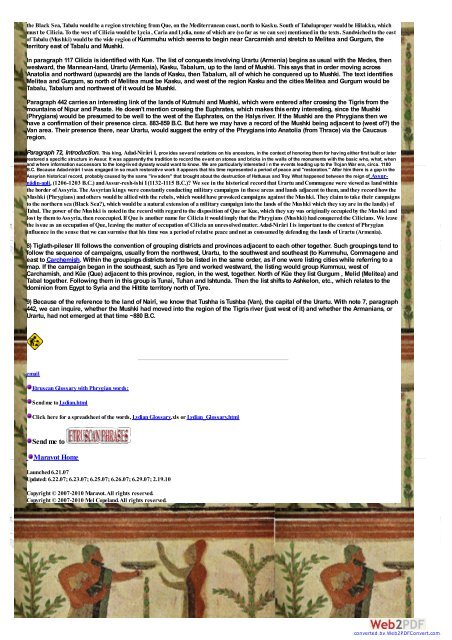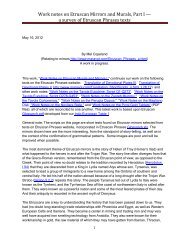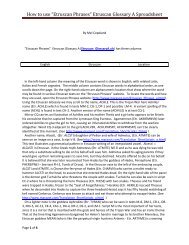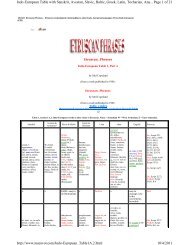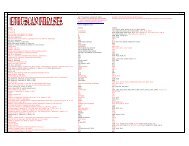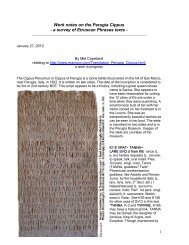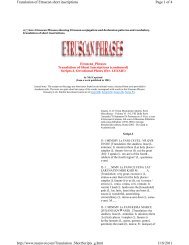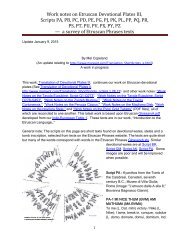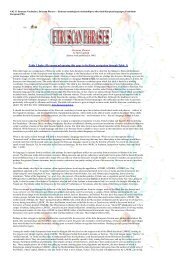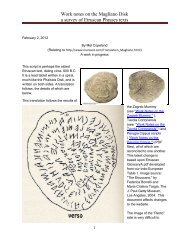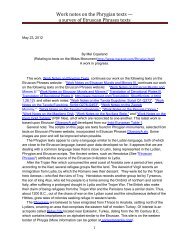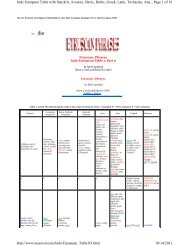Translation of the Phrygian language - maravot.com
Translation of the Phrygian language - maravot.com
Translation of the Phrygian language - maravot.com
You also want an ePaper? Increase the reach of your titles
YUMPU automatically turns print PDFs into web optimized ePapers that Google loves.
<strong>the</strong> Black Sea, Tabalu would be a region stretching from Que, on <strong>the</strong> Mediterranean coast, north to Kasku. South <strong>of</strong> Tabaluproper would be Hilakku, which<br />
must be Cilicia. To <strong>the</strong> west <strong>of</strong> Cilicia would be Lycia , Caria and Lydia, none <strong>of</strong> which are (so far as we can see) mentioned in <strong>the</strong> texts. Sandwiched to <strong>the</strong> east<br />
<strong>of</strong> Tabalu (Mushki) would be <strong>the</strong> wide region <strong>of</strong> Kummuhu which seems to begin near Carcamish and stretch to Melitea and Gurgum, <strong>the</strong><br />
territory east <strong>of</strong> Tabalu and Mushki.<br />
In paragraph 117 Cilicia is identified with Kue. The list <strong>of</strong> conquests involving Urartu (Armenia) begins as usual with <strong>the</strong> Medes, <strong>the</strong>n<br />
westward, <strong>the</strong> Mannean-land, Urartu (Armenia), Kasku, Tabalum, up to <strong>the</strong> land <strong>of</strong> Mushki. This says that in order moving across<br />
Anatolia and northward (upwards) are <strong>the</strong> lands <strong>of</strong> Kasku, <strong>the</strong>n Tabalum, all <strong>of</strong> which he conquered up to Mushki. The text identifies<br />
Melitea and Gurgum, so north <strong>of</strong> Melitea must be Kasku, and west <strong>of</strong> <strong>the</strong> region Kasku and <strong>the</strong> cities Melitea and Gurgum would be<br />
Tabalu, Tabalum and northwest <strong>of</strong> it would be Mushki.<br />
Paragraph 442 carries an interesting link <strong>of</strong> <strong>the</strong> lands <strong>of</strong> Kutmuhi and Mushki, which were entered after crossing <strong>the</strong> Tigris from <strong>the</strong><br />
mountains <strong>of</strong> Nipur and Pasate. He doesn't mention crossing <strong>the</strong> Euphrates, which makes this entry interesting, since <strong>the</strong> Mushki<br />
(<strong>Phrygian</strong>s) would be presumed to be well to <strong>the</strong> west <strong>of</strong> <strong>the</strong> Euphrates, on <strong>the</strong> Halys river. If <strong>the</strong> Mushki are <strong>the</strong> <strong>Phrygian</strong>s <strong>the</strong>n we<br />
have a confirmation <strong>of</strong> <strong>the</strong>ir presence circa. 883-859 B.C. But here we may have a record <strong>of</strong> <strong>the</strong> Mushki being adjacent to (west <strong>of</strong>?) <strong>the</strong><br />
Van area. Their presence <strong>the</strong>re, near Urartu, would suggest <strong>the</strong> entry <strong>of</strong> <strong>the</strong> <strong>Phrygian</strong>s into Anatolia (from Thrace) via <strong>the</strong> Caucaus<br />
region.<br />
Paragraph 72, Introduction. This king, Adad-Nirâri I, provides several notations on his ancestors, in <strong>the</strong> context <strong>of</strong> honoring <strong>the</strong>m for having ei<strong>the</strong>r first built or later<br />
restored a specific structure in Assur. It was apparently <strong>the</strong> tradition to record <strong>the</strong> event on stones and bricks in <strong>the</strong> walls <strong>of</strong> <strong>the</strong> monuments with <strong>the</strong> basic who, what, when<br />
and where information successors to <strong>the</strong> long-lived dynasty would want to know. We are particularly interested i n <strong>the</strong> events leading up to <strong>the</strong> Trojan War era, circa. 1180<br />
B.C. Because Adad-nirâri I was engaged in so much restorative work it appears that his time represented a period <strong>of</strong> peace and "restoration." After him <strong>the</strong>re is a gap in <strong>the</strong><br />
Assyrian historical record, probably caused by <strong>the</strong> same "invaders" that brought about <strong>the</strong> destruction <strong>of</strong> Hattusus and Troy. What happened between <strong>the</strong> reign <strong>of</strong> Assurnâdin-apli,<br />
(1206-1203 B.C.) and Assur-resh-ishi I (1132-1115 B.C.)? We see in <strong>the</strong> historical record that Urartu and Commagene were viewed as land within<br />
<strong>the</strong> border <strong>of</strong> Assyria. The Assyrian kings were constantly conducting military campaigns in <strong>the</strong>se areas and lands adjacent to <strong>the</strong>m, and <strong>the</strong>y record how <strong>the</strong><br />
Mushki (<strong>Phrygian</strong>s) and o<strong>the</strong>rs would be allied with <strong>the</strong> rebels, which would have provoked campaigns against <strong>the</strong> Mushki. They claim to take <strong>the</strong>ir campaigns<br />
to <strong>the</strong> nor<strong>the</strong>rn sea (Black Sea?), which would be a natural extension <strong>of</strong> a military campaign into <strong>the</strong> lands <strong>of</strong> <strong>the</strong> Mushki which <strong>the</strong>y say are in <strong>the</strong> land(s) <strong>of</strong><br />
Tabal. The power <strong>of</strong> <strong>the</strong> Mushki is noted in <strong>the</strong> record with regard to <strong>the</strong> disposition <strong>of</strong> Que or Kue, which <strong>the</strong>y say was originally occupied by <strong>the</strong> Mushki and<br />
lost by <strong>the</strong>m to Assyria, <strong>the</strong>n reoccupied. If Que is ano<strong>the</strong>r name for Cilicia it would imply that <strong>the</strong> <strong>Phrygian</strong>s (Mushki) had conquered <strong>the</strong> Cilicians. We leave<br />
<strong>the</strong> issue as an occupation <strong>of</strong> Que, leaving <strong>the</strong> matter <strong>of</strong> occupation <strong>of</strong> Cilicia an unresolved matter. Adad-Nirâri I is important to <strong>the</strong> context <strong>of</strong> <strong>Phrygian</strong><br />
influence in <strong>the</strong> sense that we can surmise that his time was a period <strong>of</strong> relative peace and not as consumed by defending <strong>the</strong> lands <strong>of</strong> Urartu (Armenia).<br />
8) Tiglath-pileser III follows <strong>the</strong> convention <strong>of</strong> grouping districts and provinces adjacent to each o<strong>the</strong>r toge<strong>the</strong>r. Such groupings tend to<br />
follow <strong>the</strong> sequence <strong>of</strong> campaigns, usually from <strong>the</strong> northwest, Urartu, to <strong>the</strong> southwest and sou<strong>the</strong>ast (to Kummuhu, Commagene and<br />
east to Carchemish. Within <strong>the</strong> groupings districts tend to be listed in <strong>the</strong> same order, as if one were listing cities while referring to a<br />
map. If <strong>the</strong> campaign began in <strong>the</strong> sou<strong>the</strong>ast, such as Tyre and worked westward, <strong>the</strong> listing would group Kummuu, west <strong>of</strong><br />
Carchamish, and Kûe (Que) adjacent to this province, region, in <strong>the</strong> west, toge<strong>the</strong>r. North <strong>of</strong> Kûe <strong>the</strong>y list Gurgum , Melid (Melitea) and<br />
Tabal toge<strong>the</strong>r. Following <strong>the</strong>m in this group is Tunai, Tuhan and Ishtunda. Then <strong>the</strong> list shifts to Ashkelon, etc., which relates to <strong>the</strong><br />
dominion from Egypt to Syria and <strong>the</strong> Hittite territory north <strong>of</strong> Tyre.<br />
9) Because <strong>of</strong> <strong>the</strong> reference to <strong>the</strong> land <strong>of</strong> Nairî, we know that Tushha is Tushba (Van), <strong>the</strong> capital <strong>of</strong> <strong>the</strong> Urartu. With note 7, paragraph<br />
442, we can inquire, whe<strong>the</strong>r <strong>the</strong> Mushki had moved into <strong>the</strong> region <strong>of</strong> <strong>the</strong> Tigris river (just west <strong>of</strong> it) and whe<strong>the</strong>r <strong>the</strong> Armanians, or<br />
Urartu, had not emerged at that time ~880 B.C.<br />
email<br />
Etruscan Glossary with <strong>Phrygian</strong> words:<br />
Send me to Lydian.html<br />
Click here for a spreadsheet <strong>of</strong> <strong>the</strong> words, Lydian Glossary.xls or Lydian_Glossary.html<br />
Send me to<br />
Maravot Home<br />
Launched 6.21.07<br />
Updated: 6.22.07; 6.23.07; 6.25.07; 6.26.07; 6.29.07; 2.19.10<br />
Copyright © 2007-2010 Maravot. All rights reserved.<br />
Copyright © 2007-2010 Mel Copeland. All rights reserved.<br />
converted by Web2PDFConvert.<strong>com</strong>


